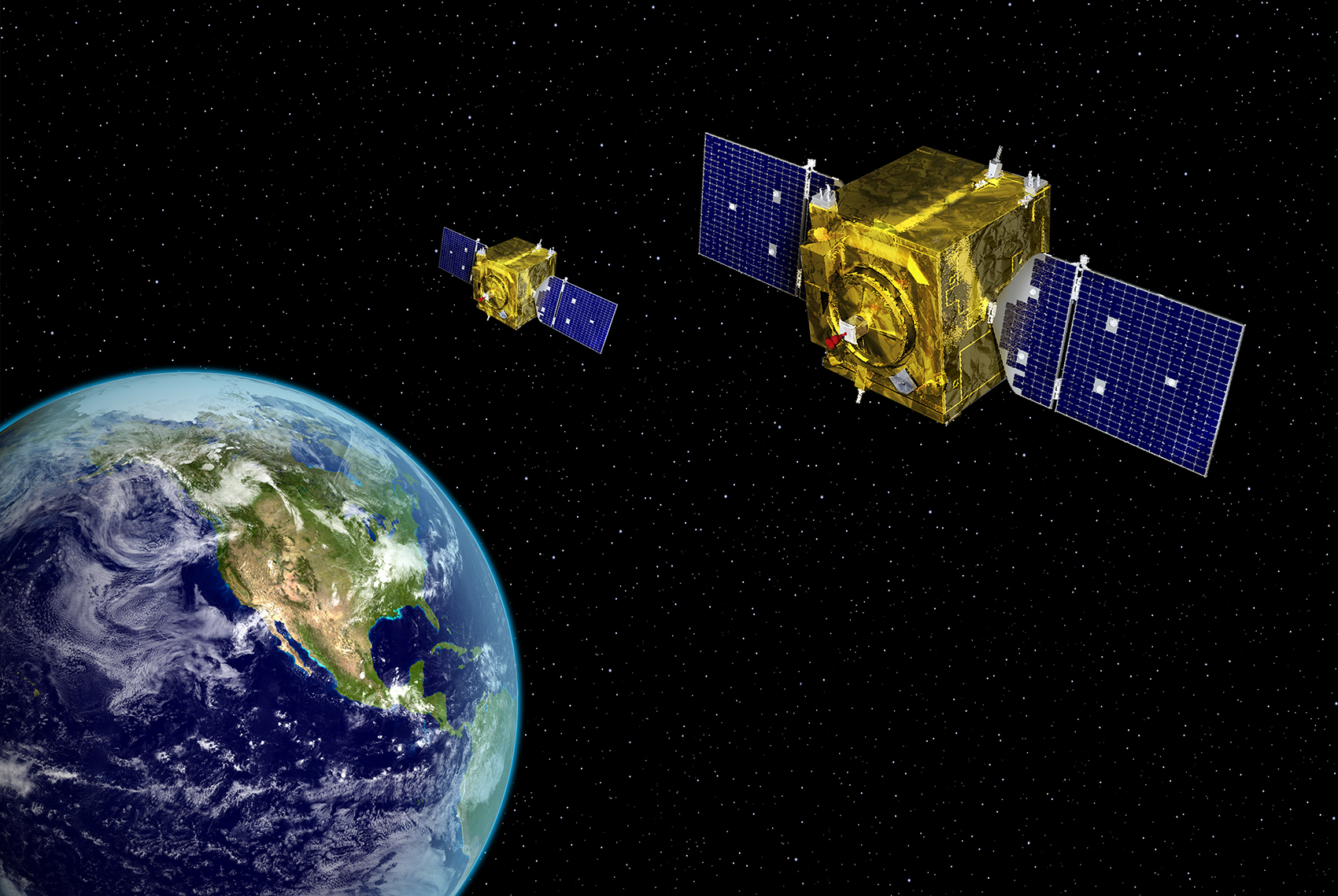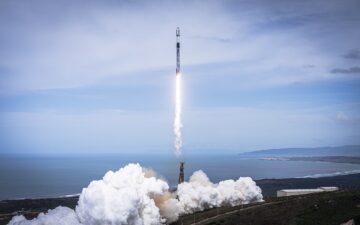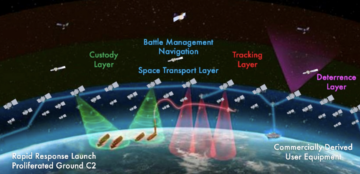
HELSINKI — Chinese researchers have noted close approaches by U.S. GSSAP satellites to Chinese spacecraft in the geostationary belt, describing the activities as threats.
A paper published in the Chinese journal Infrared and Laser Engineering earlier this year assessed the U.S. Air Force’s Geosynchronous Space Situational Awareness Programme (GSSAP) and its activities. The authors are affiliated to branches of the Chinese Academy of Sciences and the Qian Xuesen Laboratory of Space Technology under the China Academy of Space Technology.
The study looks at two-line orbital elements from GSSAP satellites in recent years, combining these with the orbital information from Chinese satellites in the geostationary belt. The authors found 14 potential close approaches to Chinese spacecraft made by GSSAP satellites across 2020 and 2021.
These rendezvous and proximity operations (RPO) include both flybys and fly-arounds, with one incident—the approach of GSSAP-4 to Shijian-20 in May 2021—being as close as 9.54 kilometers. The data was found to closely match that in the Secure World Foundation’s Global Counterspace Report.
The researchers presented simulated imagery at varying angles and distances, suggesting that an approach to within 10 kilometers of may be optimal for acquiring images of targeted space objects.
The study concluded that, through close approaches and high-resolution fine imaging, details of the target would be clearly seen, presenting a serious threat to China’s high value assets in GEO.
The activities described by the study are an increasingly common phenomenon, with the U.S., China and Russia all looking to surveil each others’ assets, in what has been described as an in-orbit Game of cat and mouse. The data from the Chinese study provides a new insight at events 36,000 kilometers above the Earth.
“I think the simulation data is very useful because there’s not a lot of details on these types of activities in the public domain,” Brian Weeden, Secure World Foundation director of program planning, told SpaceNews. “The simulation provides more insight into both what is happening and also the national security implications of these activities.”
But at the same time, the discussion cannot be only focused on GSSAP. “I don’t think it’s possible to only talk about the American GSSAP satellites without also talking about the very similar activities of the Russian Luch Olymp-K and Chinese SJ-17 satellites. This is really about a whole new category of space activities, not one specific satellite.”
Luch is a satellite long known for its activities in GEO, while Shijian-17 launched in 2016 and carries a robotic arm. China launched a “space debris mitigation satellite” named Shijian-21 in 2021 which docked with and towed a dead Chinese satellite into a graveyard orbit, demonstrating dual-use capabilities. TJS-3 meanwhile is a Chinese GEO spacecraft making its own RPOs.
The researchers’ claim of GSSAP to be a threat is limited in a sense, says Weeden, stating that these RPOs do not appear to present a physical threat to the satellites they visit, either through aggressive action or a high risk of collision.
“However, I think countries do consider them to be intelligence threats as these types of close approaches can allow for imaging and other kinds of intelligence collection that was not previously possible, which in turn could reveal capabilities and limitations of sensitive national security satellites.”
The issue of uncoordinated close approaches in GEO has generated a level of shared concern, says Weeden, noting that several countries have identified these as a pressing security issue, adding that the U.S., Russia and China have all cited each other’s RPO activities as potential threats and irresponsible behaviors in the discussions in the UN Open Ended Working Group on Space Threats over the last two years.
“However, there have not been any proposals yet from those countries about what can be done to deal with those threats. It is very difficult to decide what “too close” means in the context of close approaches in space from a technical perspective, let alone come up with something that can get consensus.
“I think we will eventually have to develop those proposals and reach that consensus, because this issue is only going to get worse with the increased geopolitical tensions on space security,” says Weeden.
- SEO Powered Content & PR Distribution. Get Amplified Today.
- PlatoData.Network Vertical Generative Ai. Empower Yourself. Access Here.
- PlatoAiStream. Web3 Intelligence. Knowledge Amplified. Access Here.
- PlatoESG. Automotive / EVs, Carbon, CleanTech, Energy, Environment, Solar, Waste Management. Access Here.
- PlatoHealth. Biotech and Clinical Trials Intelligence. Access Here.
- ChartPrime. Elevate your Trading Game with ChartPrime. Access Here.
- BlockOffsets. Modernizing Environmental Offset Ownership. Access Here.
- Source: https://spacenews.com/chinese-study-finds-gssap-close-approaches-a-threat-to-its-geo-assets/
- :has
- :is
- :not
- $UP
- 000
- 10
- 14
- 2016
- 2020
- 2021
- 36
- 54
- 9
- a
- About
- above
- Academy
- acquiring
- across
- Action
- activities
- adding
- Affiliated
- aggressive
- AIR
- All
- allow
- alone
- also
- American
- an
- and
- any
- appear
- approach
- approaches
- ARE
- ARM
- AS
- assessed
- Assets
- At
- authors
- awareness
- BE
- because
- been
- behaviors
- both
- branches
- Brian
- by
- CAN
- Can Get
- cannot
- capabilities
- CAT
- Category
- China
- Chinas
- chinese
- cited
- claim
- clearly
- Close
- closely
- collection
- combining
- come
- Common
- Concern
- concluded
- Consensus
- Consider
- context
- could
- countries
- data
- dead
- deal
- decide
- demonstrating
- described
- details
- develop
- difficult
- Director
- discussion
- discussions
- do
- domain
- done
- Dont
- each
- Earlier
- earth
- either
- elements
- ended
- Engineering
- events
- eventually
- finds
- fine
- focused
- For
- found
- Foundation
- from
- game
- generated
- geopolitical
- get
- Global
- going
- Group
- Happening
- Have
- High
- high value
- high-resolution
- http
- HTTPS
- i
- identified
- images
- Imaging
- implications
- in
- include
- increased
- increasingly
- information
- insight
- Intelligence
- into
- issue
- IT
- ITS
- journal
- jpg
- known
- laboratory
- laser
- Last
- launched
- let
- Level
- limitations
- Limited
- Long
- looking
- LOOKS
- Lot
- made
- Making
- Match
- May..
- means
- Meanwhile
- mitigation
- more
- Named
- National
- national security
- New
- noted
- noting
- objects
- of
- on
- ONE
- only
- open
- Operations
- optimal
- or
- Orbit
- Other
- over
- own
- Paper
- perspective
- phenomenon
- physical
- planning
- plato
- Plato Data Intelligence
- PlatoData
- possible
- potential
- present
- presented
- pressing
- previously
- Program
- programme
- Proposals
- provides
- public
- reach
- really
- recent
- report
- researchers
- reveal
- Risk
- Robotic
- Russia
- russian
- s
- same
- satellite
- satellites
- says
- SCIENCES
- secure
- security
- seen
- sense
- sensitive
- serious
- several
- shared
- similar
- simulation
- something
- Space
- spacecraft
- specific
- stating
- Study
- Talk
- talking
- Target
- targeted
- Technical
- Technology
- tensions
- that
- The
- Them
- There.
- These
- they
- Think
- this
- this year
- those
- threat
- threats
- Through
- time
- to
- TURN
- two
- types
- u.s.
- UN
- under
- value
- very
- Visit
- was
- we
- What
- What is
- which
- while
- whole
- will
- with
- within
- without
- working
- Working Group
- world
- worse
- would
- year
- years
- yet
- zephyrnet









